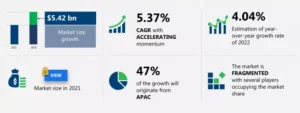Silicone adhesives and sealants market forecast to reach $5.4 billion by 2026
New York, NY – The silicone adhesives and sealants market share is expected to increase by USD 5.42 billion from 2021 to 2026, and the market’s growth momentum will accelerate at a CAGR of 5.37% according to the latest report from Technavio.
This silicone adhesives and sealants market research report provides valuable insights on the post COVID-19 impact on the market, which will help companies evaluate their business approaches. Furthermore, this report extensively covers silicone adhesives and sealants market segmentation by application (building and construction, paper and packaging, transportation, and others) and Geography (APAC, Europe, North America, South America, and MEA). The silicone adhesives and sealants market report also offers information on several market vendors, including 3M Co., Arkema SA, Avery Dennison Corp., DELO Industrie Klebstoffe GmbH & Co. KGaA, Dow Inc., General Sealants Inc., H.B. Fuller Co., Henkel AG, and Co. KGaA, Illinois Tool Works Inc., and Sika AG among others.
The conducive properties of silicone for electrical applications is notably driving the silicone adhesives and sealants market growth, although factors such as slowdown in global automotive production may impede the market growth. Our research analysts have studied the historical data and deduced the key market drivers and the COVID-19 pandemic impact on the silicone adhesives and sealants industry. The holistic analysis of the drivers will help in deducing end goals and refining marketing strategies to gain a competitive edge.
The conducive properties of silicone for electrical applications is one of the key drivers supporting the silicone adhesives and sealants market growth. Silicone adhesives and sealants can be used for the adhesion and sealing of electrical & electronic components. They have various conducive properties as they are insulative, flame-retardant, electrically conductive, and ultra-heat-resistant. For instance, CSL Silicones Inc. offers self-leveling electronic grade silicone adhesives and sealants. They can be used to fill small spaces such as potting electrical terminals and sealing electronic devices. The company’s silicone adhesives and sealants do not generate acetic acid or other corrosive by-products during curing. Thus, they are ideal for use in corrosion-sensitive electronic equipment as they do not corrode copper, brass, or silver. Thus, the usage of silicone adhesives and sealants for electrical applications will drive the growth of the market during the forecast period.
The growing usage for bonding medical devices is another factor supporting the silicone adhesives and sealants market growth. Silicone adhesives and sealants are used for bonding in medical devices due to their ability to bond and adhere, unlike surfaces. Some medical devices are made using polycarbonates as they can be easily shaped and molded. Additionally, materials such as polyamides and nylon are used for manufacturing tubing and catheters. Silicone adhesives and sealants are inert and ideal for bonding and sealing medical devices made from these materials. They offer a long-lasting seal which is a necessity for medical devices. Single component moisture curing RTV silicone adhesives are the most common silicone adhesives used in medical devices. Such application will drive the market growth during the forecast period.
The slowdown in global automotive production is one of the factors hindering the silicone adhesives and sealants market growth. In 2019, world automotive production declined by 5% since less than 92.2 million cars, trucks, and buses were manufactured. The automotive manufacturing industry in China had a production share of 28% of the global market in 2019, as 25.7 million vehicles were manufactured in the country. This was a 7.5% year-on-year decline as compared to the previous year. This slowdown in global automobile production continued in 2020 due to the COVID-19 pandemic. According to the International Organization of Motor Vehicle Manufacturers (OICA), there was a 16% decline in the production of motor vehicles in 2020 as less than 78 million cars were produced. This was equivalent to the sales level of 2010. These factors will negatively impact the growth of the market during the forecast period.

